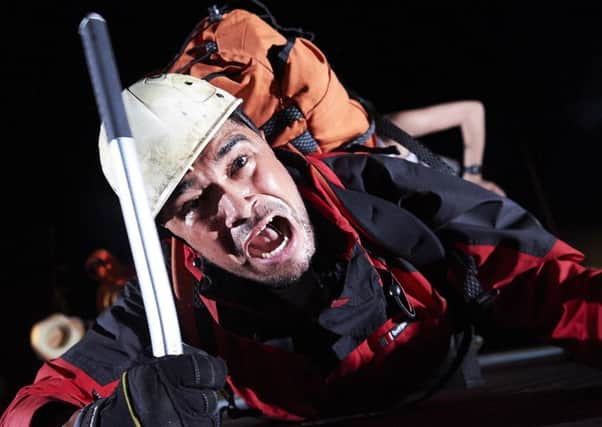Touching the Void: bringing the mountains into the theatre


If you were to pick a story which is challenging to put on in a theatre, you might choose one in which the action happens 19,000 feet up a dangerous mountain. Or one in which the two main characters are alone most of the time, significantly reducing the opportunities for drama. Or one in which, thanks to the bestselling book and BAFTA award-winning film, the outcome is already well known.
You might, in fact, choose Touching the Void, the story of young British climbers Joe Simpson and Simon Yates, who ran into difficulties descending the West Face of Siula Grande in the Peruvian Andes in 1985. After breaking his leg and falling into a crevasse, Simpson was presumed dead, but in fact made a heroic three-day crawl back to base camp, giving us one of the great climbing survival stories of all time.
Advertisement
Hide AdThe obvious staging difficulties did not deter playwright David Greig, or director Tom Morris, whose co-production is about to open at Edinburgh’s Royal Lyceum Theatre. “I’m drawn to things that appear to be theatrically difficult,” says Greig. “And Tom Morris’s whole career has been about making work which is surprising and interesting. It’s only surprising if you think it can’t be done, so you have to offer someone like him things you think they can’t do.”
The ambitious production premiered at Bristol Old Vic (where Morris is artistic director) in the autumn, reopening the theatre after a £25million refurbishment. It will tour to the Hong Kong Arts Festival in February, before returning to Scotland for dates at Perth Theatre and Eden Court, Inverness.
Morris, whose past work includes Swallows and Amazons, Newsnight: The Opera and co-directing War Horse for the National Theatre of Great Britain, says he has been fascinated by Touching the Void ever since he saw Kevin Macdonald’s highly acclaimed drama-documentary in 2004.
“As happens, I think, with a lot of people who encounter the story, I couldn’t get it out of my head, because it is one of those stories which seems to uncover at least two absolutely archetypal, almost mythic moments of decision.”
Yates, roped to Simpson but unable to rescue him, made the monumental decision to cut the rope between them rather than risk being dragged to his death. Simpson, who had plummeted part-way down a crevasse but survived the fall, then faced another decision: with a badly broken leg and weather conditions worsening, whether to try to save himself.
“These are the moments people who have discovered the story wake up in the night thinking about, asking themselves what they would have the capacity to do in that situation,” says Morris. “From the beginning, I was attracted to it as a piece of theatre because, even though on the surface you might think it is all about that specific landscape and extreme physical duress, in fact both of these moments are incredibly simple human moments.”
Advertisement
Hide AdGreig said the topic came up when the two directors were discussing ways their theatres could collaborate. His own long interest in climbing was one of the prompts for 8000 Metres, which he wrote for Suspect Culture in 2004, and he jumped at the chance to adapt Touching the Void.
“Although there might have been some good writers around who could do it better, I would have had to kill them,” he grins. “In Scotland I’m a hill-walker and a runner, so I already had a feeling for that world. I’m also terrified of it, even looking at a cliff makes me feel physically sick, so that was a good mixture of love and dread to bring to the subject matter.”
Advertisement
Hide AdBoth Morris and Greig were committed to using the full toolbox of theatre to recreate on stage the story’s sense of danger and tension. “We watched films of free climbing on the internet, and even sitting alone in front of a computer we noticed how your palms would sweat and your heart rate would change,” says Morris. “We wanted to explore that in theatre, use whatever we could to give the audience that experience.”
Meanwhile, Greig’s adaptation manages to add a few twists to the tale, keeping the audience guessing about the outcome. He felt vindicated when, after a preview in Bristol, he heard one audience member in the bar ask another: “Does he (Simpson) die in the book?” and the other reply “I don’t know, I’ll have to check when I get home.”
None of this should be a surprise to theatre-goers. After all, we know what happens in Hamlet, but that does nothing to reduce the tension in a good production. Good theatre harnesses the most powerful tool of all, the audience’s imagination, taking us to places we’ve never been, whether that’s the court of Elsinore or halfway up a mountain. Both Morris and Greig hope that the popularity of the Touching the Void story will also attract new theatre-going audiences to discover that power for themselves.
At the end of the day, Greig says, it’s not really about mountains. “It’s about trust and life, how hard would you work to stay alive and why, real existential questions. I wanted to write something that explored that. There isn’t really a bigger topic to explore than life or death. ‘To be or not to be, that is the question’, and that is the question that faces Joe Simpson, halfway down a crevasse. And this is how he answers it.”
Touching the Void is at the Royal Lyceum, Edinburgh, from 24 January until 16 February